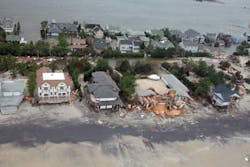Climate Change, Water Issues Attract Presidential Attention
By Patrick Crow, WaterWorld Correspondent
References to water issues saturated President Barack Obama's speech in late June about his climate change initiative. The announcement referred to the effects of global warming on water availability, flooding and droughts. It discussed the issues of changing water cycle intensity and the increasing frequency of hydrologic extremes.
Increasingly, water groups have been warning policymakers about the long-term impact that climate change could have on drinking water resources. In his 2013 State of the Union Address, the president said that if Congress failed to act to reduce greenhouse gas emissions, he would issue a series of executive orders based on the administration's regulatory powers. The president does not need congressional approval for his actions, although legislators can affect them by limiting or expanding annual appropriations to the agencies involved.
President Obama's climate action plan has the goals of reducing U.S. carbon emissions, preparing the nation for climate change impacts and leading international efforts to fight climate change. The plan directs the Environmental Protection Agency (EPA) to "integrate considerations of climate change impacts and adaptive measures into its Clean Water and Drinking Water State Revolving Funds."
It includes initiatives to increase infrastructure resiliency, such as directing federal agencies to remove regulatory barriers to making "climate-resilient investments," and supporting federal grants and technical assistance for several sectors, including water management.
President Obama suggested that assistance would be available to build "hardened water systems." He pointed to Miami Beach, Fla., as an example of a community working to protect its water supply against "seeping seawater."
The initiative would establish an interagency National Drought Resilience Partnership to help communities plan for and reduce drought impacts, develop adaptation strategies for freshwater bodies and other environmental resources, and boost climate research and assessments of climate change impacts on U.S. regions.
Most of the plan focuses on President Obama's directive to the EPA to develop regulations limiting carbon pollution from power plants. The EPA would propose the emissions rule for existing power plants by June 2014 and finalize it one year later.
Dan Harnett, a spokesman for the Association of Metropolitan Water Agencies, said water groups have been focused on the potential impacts of global warming threats for some time. "The main takeaway for us was that the president did make a strong statement on the need to develop and protect water infrastructure," he said. "This is a plan that basically attempts to work around Congress, so there are a lot of questions about whether all of these measures can be implemented to achieve the intended effects."
Congress reacted typically to the president's outline, with democrats generally praising the environmental goals of the plan and republicans voicing concerns about its potential costs to consumers and businesses.
Rep. Lois Capps (D-Calif.), who earlier this year introduced a bill to help states and municipalities adapt their water and wastewater infrastructure to changing hydrological conditions, said the president's blueprint was "imperative" to prepare for the impacts of climate change.
Sen. Barbara Boxer (D-Calif.), Chairman of the Environment and Public Works Committee, said, "The president is using all of the tools in his toolbox, and I applaud him for that."
Environmental groups were strongly supportive of the plan. Clean Water Action noted that climate change impacts are already affecting water resources. "Acting now to curb carbon pollution could head [off] the threat of extreme weather events like superstorm Sandy, and could also prevent severely challenging climate-related drinking water impacts that would otherwise be felt nationwide," it said.
The Sierra Club said, "This is the change we have been waiting for on climate. While we must reduce pollution further to truly address dangerous climate disruption, we applaud the administration's continued commitment to reducing greenhouse gas emissions by 17 percent by 2020. This plan includes key steps to reaching that goal."
The Natural Resources Defense Council said, "Climate change is the central environmental crisis of our time. It is taking a grievous and growing toll on our country, threatening our people and imperiling our future. The President promised to do something about it. Today he turned that promise into action."

